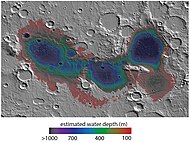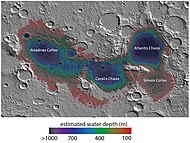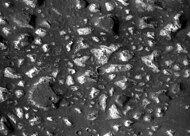Eridania Lake is a hypothesized ancient lake on Mars with a surface area of roughly 1.1 million square kilometers. It is located at the source of the Ma'adim Vallis outflow channel and extends into Eridania quadrangle and the Phaethontis quadrangle. As Eridania Lake dried out in the late Noachian epoch it divided into a series of smaller lakes.
-
 Map showing estimated water depth in different parts of Eridania Sea This map is about 850 km (530 miles) across.
Map showing estimated water depth in different parts of Eridania Sea This map is about 850 km (530 miles) across.
-
 Features around Eridania Sea labeled
Features around Eridania Sea labeled
Later research with CRISM found thick deposits, greater than 400 meters thick, that contained the minerals saponite, talc-saponite, Fe-rich mica (for example, glauconite-nontronite), Fe- and Mg-serpentine, Mg-Fe-Ca-carbonate and probable Fe-sulphide. The Fe-sulphide probably formed in deep water from water heated by volcanoes. Such a process, classified as hydrothermal may have been a place where life began. Some sources say clay deposits can be up to 2 km thick.
-
 Deep-basin deposits from the floor of Eridania Sea. The mesas on the floor are there because they were protected against intense erosion by deep water/ice cover. CRISM measurements show minerals may be from seafloor hydrothermal deposits. Life may have originated in this sea.
Deep-basin deposits from the floor of Eridania Sea. The mesas on the floor are there because they were protected against intense erosion by deep water/ice cover. CRISM measurements show minerals may be from seafloor hydrothermal deposits. Life may have originated in this sea.
-
 Diagram showing how volcanic activity may have caused deposition of minerals on floor of Eridania Sea. Chlorides were deposited along the shoreline by evaporation.
Diagram showing how volcanic activity may have caused deposition of minerals on floor of Eridania Sea. Chlorides were deposited along the shoreline by evaporation.
See also
References
- Rossman, P. Irwin III; Ted A. Maxwell; Alan D. Howard; Robert A. Craddock; David W. Leverington (21 June 2002). "A Large Paleolake Basin at the Head of Ma'adim Vallis, Mars". Science. 296 (5576): 2209–2212. Bibcode:2002Sci...296.2209R. doi:10.1126/science.1071143. PMID 12077414. S2CID 23390665.
- de Pablo, M. A.; Fairén, A. G.; Márquez, A. (3 March 2004). "The Geology of Atlantis Basin, Mars, and Its Astrobiological Interest" (PDF). 35th Lunar and Planetary Science Conference, 15–19 March 2004, League City, Texas: 1223. Bibcode:2004LPI....35.1223D. abstract no.1223.
- Cabrol, N. and E. Grin (eds.). 2010. Lakes on Mars. Elsevier. NY.
- Rossman, R.; et al. (2002). "A large paleolake basin at the head of Ma'adim Vallis, Mars". Science. 296 (5576): 2209–2212. Bibcode:2002Sci...296.2209R. doi:10.1126/science.1071143. PMID 12077414. S2CID 23390665.
- "HiRISE | Chaos in Eridania Basin (ESP_037142_1430)".
- Joseph R. Michalski, Eldar Z. Noe Dobrea, Paul B. Niles & Javier Cuadros (10 July 2017). "Ancient hydrothermal seafloor deposits in Eridania basin on Mars". Nature Communications. 8: 15978. Bibcode:2017NatCo...815978M. doi:10.1038/ncomms15978. PMC 5508135. PMID 28691699.
{{cite journal}}: CS1 maint: multiple names: authors list (link) - Morden, S. 2022. The Red Planet. Pegasus Books. New York.
External links
Portal:
This article about geology, geography or other features of the planet Mars or its moons is a stub. You can help Misplaced Pages by expanding it. |